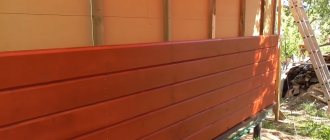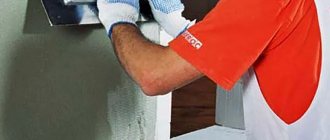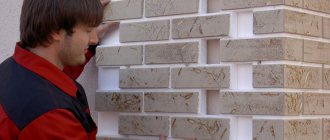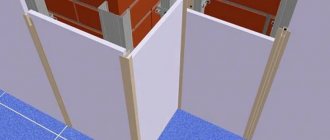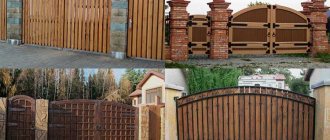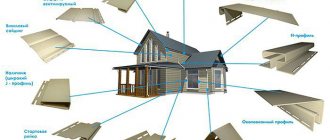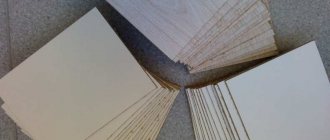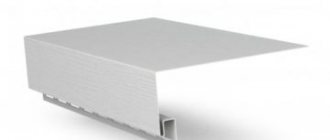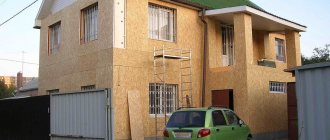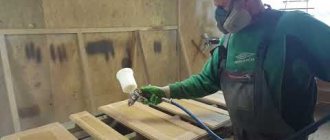Other materials
When choosing how to sheathe the inside of a garage door, many people prefer foil-clad isolon, which is what elastic polyethylene foam is called. It also provides reliable insulation, and installing it on the gate is much faster than polystyrene foam with wooden sheathing. This cladding, made with liquid nails, provides reliable heat and sound insulation. Another material that can be used to sheathe the inside of garage doors is penoizol. This is a liquid foam that can be used to create a seamless layer.
Quite a lot of insulation methods have been invented, but the main principle is the same: the entire area of the metal gate must be completely covered with insulating material, otherwise it will still be cold in the garage. Proper insulation will allow you to maintain a comfortable temperature all winter.
Give me advice on garage door trim materials!
For one standard 2*3 gate you will need:
No matter how many different things I have seen, there are certain disadvantages in some things.
What do you need from insulation?
What would be warmer.
If it’s warm in the garage, then when it’s cold, the metal condenses moisture, and it needs to be reliably cut off.
We glue self-adhesive isolon onto the painted gates. why her?
Yes, because any glue, and especially foam, will leave unadhesive areas. where condensation will form.
Next, we screw the slats over the isolon, again, so that there is no contact with the metal and the slats do not rot.
We glue the polystyrene foam onto the isolon using adhesive for strip tiles. Here the air is no longer particularly important.
We sew panels or lining, or something else onto the slats.
There was never any leakage or dripping from the gate, there was no frost anywhere, I often heat the garage up to +16. It has never been below -3 in the garage either.
If the garage is unheated, then there is absolutely no point in insulating it. This will not add heat.
Selection of thermal insulation material
To insulate garage doors, a combination of materials is most often selected, one of which serves as a heat insulator, and the second prevents the penetration of cold air. Important! There are special requirements for garage door insulation. Due to the increased fire hazard of the premises, they must have a fairly high degree of fire resistance. An undesirable factor is water permeability, as well as the ability of the material to accumulate moisture, which can lead to the appearance of fungus.
The following can be used as insulation:
• stone wool; • fiberglass materials; • non-flammable polymers (marked with the letter “C” and self-extinguishing).
For cladding
Cement-bonded particle boards, glass-magnesium boards or fire-resistant wood boards with a special impregnation that reduces their flammability can be used. If the insulation does not have a waterproofing layer, it is better to lay a non-flammable reinforced film or construction foil between the insulation layer and the cladding.
Stone (basalt) wool
This is a fibrous fire-resistant material with fairly high sound and heat insulation properties and high wear resistance. It has a low degree of water absorption and is not able to absorb moisture. The high environmental friendliness of the material allows it to be used for finishing any type of premises.
Basalt (stone) wool with waterproofing foil
Foam plastic
Polystyrene foam is a fairly durable and lightweight insulation material that has a low degree of vapor absorption, and when flame retardant additives are introduced into it, its ability to burn becomes minimal. It can be operated over a wide temperature range: from +60 to -50°C.
Polystyrene foam as insulation
Polystyrene foam
The material, in fact, is a type of polystyrene foam and has a similar composition, but its density is higher and its thermal conductivity is significantly lower. The degree of flammability of polystyrene foam is indicated on the marking: for finishing a garage, it is advisable to choose material of the NG (non-flammable) or G1 (moderately flammable) brands. The disadvantages of expanded polystyrene include a low degree of protection against ultraviolet radiation, so it must be reliably protected from sunlight.
Expanded polystyrene
Liquid penoizol (urea foam)
Externally similar to expanded polystyrene, it belongs to the flammability group G-2 and G-1 and is made from thermosetting resins that do not support combustion. Manufacturers claim that its thermal insulation properties are 1.5 times higher than expanded polystyrene. The foam coming out of the balloon sleeve is able to fill all the air gaps. After 10-15 minutes. it sets, then hardens for about 3-4 hours. This material acquires its final strength only after 2-3 days.
Penoizol
Important! To insulate metal gates that quickly heat up in the sun, you should not use spontaneously combustible insulation made from natural fabrics and cotton wool, cheap types of polystyrene foam, etc.
Dew point
Dew point is the temperature at which water vapor becomes most saturated and forms condensate
.
It appears only at the heat-cold boundary. When insulating, the position of the dew point shifts: if the thickness of the heat-insulating material is sufficient, then it will be located inside it. The wall remains dry. If the garage is heated, and the thickness of the walls is not sufficient to retain heat, then it must be insulated from the outside: in this case, the dew point moves to the external insulation. Naturally, when finishing the interior of the garage, a second dew point
will appear indoors. However, with such additional restriction of the access of moisture and cold, the temperature difference will be insignificant, therefore, if there is sufficient ventilation, the amount of condensation in the room will be minimal.
Dew point in a heated room The temperature difference will not be too large when finishing an unheated room: the insulation becomes a barrier that prevents the penetration of excess moisture into the room in the warm season and protects it from cold winds in winter.
Video description
This video shows the use of mineral wool to insulate a garage.
The binding element is a formaldehyde resin that can release phenol as a result of heating. This substance has a damaging effect on health. This can absorb a lot of moisture. When planning how to make a garage door using it, you need to ensure the use of a waterproofing film.
See also: Catalog of companies that specialize in the installation of heating systems and electrical systems.
Application of foam plastic
Here we mean a whole class of materials made from polymers that have a foam base with air bubbles. The classification is made in accordance with the type of polymer used.
Garage finishing with PVC plastic panels
Finishing a garage with plastic panels begins with the installation of sheathing - wooden or metal. Or the panels are mounted without it - it depends on the material of the walls. The sheathing pitch and fasteners are selected individually in each case.
Finishing a garage with plastic has a number of advantages. Such panels are easy to clean (thanks to their tightness and special design), and they do not change their appearance - they do not turn yellow, do not fade, and scratches are not visible on them, since they are completely cast from white plastic and are not painted on top. All our clients can safely say this - owners of perfect garages, of which GarageTek has already completed several hundred during its work in Russia since 2008.
Having a beautiful garage finish is important. But the main advantage of TekPanels is that they are not just a finishing material, but also serve as the basis for accessories and furniture from the GarageTek storage system - cabinets, racks, shelves, baskets, hooks, brackets, holders and other garage equipment.
EXPERT OPINION Olga, head of development department GarageTek
You can also screw shelves to regular walls. What is the difference?
Firstly, in modularity. The panels have longitudinal grooves into which mating parts of accessories are inserted. There is no need to nail or drill anything. Accessories can be easily removed and moved. A striking example of this is the garage we equipped in the “Fazenda” program on Channel 1, which we quickly changed for the winter and summer seasons. Secondly, there are more than a hundred different accessories in the GarageTek storage system. Thirdly, accessories can withstand loads from 2 to 120 kg. And on the panels you can place any number of any accessories, the main thing is not to overload each of them. Permissible loads are indicated in the GarageTek product catalog.
Application.
Industrial swing gates are most often used to create openings of medium and large sizes through which large vehicles must pass. Most often, gates are used in:
- Warehouse premises;
- Mechanical workshops;
- Garages;
- Car washes;
- Hangars intended for parking or equipment, including aircraft.
Stronger versions with increased protection are installed at facilities where access control is an important issue. Security systems installed in addition to industrial gates will work perfectly in tandem if configured correctly.
There are different models of gates; if simple and lightweight ones are suitable for garages, then for industrial enterprises they will differ not only in measurement , but also in the design itself. the electric motor needed to open and close the gate.
Choosing insulation for garage doors
Your main task for insulation is 50% the choice of material for insulation. If this is done incorrectly, then all your work, time, effort and money wasted. Insulation material is a product that has minimal thermal conductivity and is capable of retaining heat inside a building. If we talk about the construction industry, the conductivity of heat in a material is determined by the conductivity coefficient. The following principle applies here: the lower this coefficient, the better the insulation will retain heat inside.
Features of a floor with an inspection hole
The arrangement of the floor in a garage with an inspection hole has some features. There must be good waterproofing, otherwise it will simply be impossible to use. If the car sits in damp conditions for a long time, its parts will deteriorate and rot much faster. Before digging a hole for inspection, it is necessary to measure the groundwater level.
It is necessary to make a strong iron frame along the edge of the pit. It will restrain the pressure of the machine in statics and dynamics. Otherwise, the wheels will push through the screed, and its crumbs will fall directly into the hole. As additional stops, special channels are placed in the area of the wheels. It is possible to provide lighting into the pit, powered by 36 volts. If the value is higher, an accident may occur if fuel vapors ignite.
How to give an aesthetic appearance from the inside
One of the important factors is the aesthetic appearance; all the work done is assessed by it. Therefore, they are not limited to installing insulation when covering garage doors, but cover it with some kind of material.
To cover the gates on top of the insulation, 12.5 mm thick lining is suitable. It is advisable that it is subsequently deeply impregnated with paint and varnish material, since many gates open outward and can be exposed to water. The material is attached vertically to a durable wooden frame. If you used one for installing insulation, you can attach it directly to it. Before installation, it is necessary to keep the lining indoors for at least 48 hours. Garage owners, if they have the means, often do not limit themselves to covering only the gates, but also trim the walls and ceiling with clapboard. Garages finished in this way look very presentable inside.
Another type of finish that works well for lining a garage door is siding. It is easy to install. Installation of siding is carried out both on a wooden frame and on a steel profile. There is also a wooden type of siding. Siding can also be used to cover both the gate and the entire garage.
You can use plywood and OSB for cladding. Working with these materials is easy and does not require special skills. Sheathing is carried out mainly on wooden sheathing. Before installation, all wooden structures must be protected from precipitation and moisture. After that, sheets of material are attached to the finished sheathing with screws. The entire garage can be covered with plywood or OSB. After completing the sheathing, all joints must be caulked and sanded. And then you can paint it.
Another piece of advice from personal experience. You need to know the minimum temperature for storing your car. Basically, the optimal temperature for many cars is 5–10 C°. You can take the garage temperature on duty in this range. And when repair work is being carried out and you are in the garage for a long time, the temperature is temporarily raised to the desired setting using heating devices.
Video: insulating gates with foam plastic
The gates are insulated with foam plastic using foil insulation, and then sheathed with OSB sheets.
We have studied the insulation of garage doors in detail, revealed all the pros and cons, all that remains is to wish you success in completing the work.
Is it necessary to do this
The garage is used for more than just car maintenance. Some owners may use it for storage or make a workshop in this room. One of the possible options is the ability to communicate with friends. No matter what the garage is used for, it is not comfortable to be in it in the cold season without heating.
Temperatures below zero cause damage to the vehicle. If it is overcooled, it will be difficult to start it, and frozen condensation will begin to accumulate, which can damage metal parts. If you know how to insulate a garage door, this can be prevented.
Work order
Applying adhesive to foam plastic
To insulate the gate, you must follow a certain sequence:
- Inspecting surfaces for defects.
- Removing rust and cracks by stripping and caulking.
- Padding.
- Coloring.
- Preparation of wood for creating sheathing: cutting, treatment with antiseptics, installation (vertical).
- Laying thermal insulation between the slats. If necessary, foam boards should be cut into the necessary pieces that can be easily fixed. For reliability, glue is used. Make sure there are no gaps. If there are any, it is worth using polyurethane foam or sealant.
- After the installation of the foam is completed, you can proceed to covering the sash. A variety of methods and methods are suitable for this, but the simplest and most accessible is the use of boards or lining.
- At the last stage, the casing is opened with varnish or stain. The metal plate is painted.
Pay attention to the cracks during insulation, especially at the junction of two doors.
Gates insulated with polyurethane foam
Advantages.
The designs gained popularity due to the following advantages:
- High working resource. This advantage was obtained thanks to a large margin of safety and a rigid frame, which is made of steel or aluminum.
- The design itself is simple, which also makes it easy to install the gate if you have some skills.
- A wide selection of sizes, dimensions, materials, design complexity, makes it possible to place the device to suit almost any requirements.
- Providing a high level of protection with its ability to withstand severe mechanical loads and block entry during an attempt to penetrate. The territory will be completely protected from third parties.
- If the surface is covered with an anti-corrosion coating, then even over time, weather conditions will not be able to harm the appearance of the sashes. The more severe and difficult the weather conditions, the more targeted anti-corrosion agents are used as coatings.
- If we compare the cost of such doors and fencing devices, the former come out the winner, due to their flexibility and variety of available options.
How to insulate a garage door from the inside
Insulating the gate from the inside with your own hands requires preliminary preparation: after choosing the insulation material, you need to prepare the surface, and only then begin work.
Surface preparation
It is easier to carry out work when the door leaves are in a lying position. Old gate leaves require cleaning from rust, priming and protection from further corrosion. To clean, you can use one of 3 methods:
- Chemical - we treat the surface with a rust converter;
- Mechanical - using a special attachment on a drill or manually, with a brush with metal bristles;
- Painting - paints, for example "Hammerite", which are both rust converters, primers and paint compositions.
A grinder with a polymer-abrasive brush is an ideal choice for cleaning metal surfaces
If you choose a mechanical or chemical method, then after processing and cleaning the rust, the surface is dusted, degreased, primed, and then painted with a metal compound. Primers and paints based on alkyd, acrylic or pentaphthalic resins must be designed for use in conditions of high humidity and a wide range of temperatures.
Creating a sheathing
The sheathing is needed to impart rigidity to the structure and secure the insulating material. The lathing is made depending on the size and design of the gate; it can be made of wooden beams with a section of 50x50 mm or from a metal corner 50x5 mm.
The wooden beam is attached along the perimeter to the frame of the gate leaf, along the perimeter of the gate, deadbolt and lock, then horizontally, in increments of 600 minus 5 mm. The location of the sheathing elements is marked on the sheets with a marker; it is advisable to use solid bars, without joining.
The sheathing helps to attach the insulation, and will also hold the front layer of the cladding on it.
Lathing for slab insulation or mats should be done in a horizontal direction to prevent possible sliding of the insulation from its own weight. Before installing the sheathing, wooden blocks are treated with an antiseptic to prevent rotting, damage by insects and fungal diseases.
It is important! For antiseptic treatment of timber, choose a composition with a validity period of 10-25 years, so that after a couple of seasons you do not have to do the work again.
In the case of sprayed insulation, the direction of the frame does not matter, but the surface of the gate should be treated with an adhesive primer to improve the adhesion of the polyurethane foam to the metal sheet. The wooden sheathing is fastened to the frame of the canvas with galvanized self-tapping screws at 1/2 the thickness of the beam in increments of no more than 25 cm, metal sheathing - with bolts or welding.
Foam insulation
It is important! There are many videos from “homemade” companies on the Internet, in which they advertise inexpensive foam insulation, forgetting that polystyrene foam is a packaging material with an open cell structure, due to this it has high water absorption, and when saturated with moisture, it loses its heat-insulating ability and service life no more than 2-3 years. When we say “foam plastic,” we mean insulation with foamed, extruded or graphite-containing polystyrene foam with a volumetric weight of 25-30 kg/m3.
- Expanded polystyrene slabs are cut to the required size.
- For better adhesion to the metal, the smooth surface of the plate is pricked with a needle roller.
- The adhesive composition (mounting foam, adhesive foam) is applied along the perimeter of the slab, retreating 1.5-2 cm from the edge, and in the center with 1-2 marks.
- The slab is pressed against the metal and fixed with a weight, leveling it with the level of the sheathing using a rule strip.
The main rule for using polystyrene foam is that the fewer joints, the better.
The adhesive composition should not get on the end of the heat insulator to avoid the appearance of cold bridges. The gaps between the plates are filled with scraps of polystyrene foam.
Application of mineral wool
- Soft mineral wool mats are cut to the size of the sheathing cells plus 5 mm for expansion.
- The mats are coated with adhesive around the perimeter and in the center in 1-2 places.
- The mat is placed in place and pressed to secure it.
- The cracks are filled with scraps of material using polyurethane foam.
Since the water absorption of mineral wool is greater than that of expanded polystyrene and polyurethane foam, a vapor barrier film (not household polyethylene!) is stapled to the surface of the mats to prevent the material from absorbing water vapor.
Mineral wool is a gyroscopic material, therefore, before laying insulation, it is necessary to take care of waterproofing
Use of polyurethane foam
When using slab polyurethane foam, the insulation process is similar to thermal insulation with foam plastic. If you decide to spray polyurethane foam, you will need professional equipment, which you can rent, or invite a team of professionals. This will cost more, but guarantees a high-quality result. Insulation with polyurethane foam is suitable for sectional doors, since the material itself has a low volumetric weight.
It is important! When spraying, you must use a protective suit, goggles, a respirator, and work outdoors or in a room with good ventilation.
Execution of work: spraying is carried out layer by layer, monitoring the thickness of the material so that it matches the thickness of the sheathing. After the polyurethane foam has hardened, the excess foam is cut off.
Before covering the gate with polyurethane foam, it is necessary to close the openings and parts of the gate into which it is not desirable to get foam.
Finish lining
Not only will the finishing make your garage space look more inviting and lived-in, but it will also protect the polyurethane and polystyrene foam from the damaging effects of sunlight.
The interior decoration of the gate can be made from a variety of materials:
- Moisture-resistant plywood is a classic finishing option with excellent characteristics;
- OSV board is an oriented strand board, a high-quality material for external and internal cladding;
- Wooden lining;
- Plastic lining;
- Sheet plastic is opaque.
To prevent the appearance of cold bridges with metal sheathing, before attaching the finishing trim, it is advisable to glue the frame shelves and corners with foil tape.
The materials are cut to the size of the canvas. To attach plastic lining - siding, a connecting U-shaped profile is mounted around the perimeter of the canvases. The cladding is attached to the sheathing with screws in special grooves; when fastening, the screws are not screwed all the way, leaving a gap of 1.5 mm for thermal expansion. The siding orientation can be either horizontal or vertical.
After installation, plywood, OSV boards, and lining must be primed with an antiseptic and painted with a composition for wood materials for exterior use, paying special attention to protecting the ends, since this is where rotting and fungal infection begin.
General view of insulated gates after lining with moisture-resistant plywood
To finish sectional doors, you can use foil insulation made of polyethylene foam, securing it with a similar adhesive tape, or sheet plastic, which is stapled to the insulation.
The advantage of artificial materials for cladding is their resistance to rotting, durability and ease of maintenance; the disadvantage is the release of harmful substances during combustion.
Seal fastening
Particular attention should be paid to sealing the vestibules, since heat loss through cracks accounts for up to 30% of all heat loss. The seal can be single-circuit, when the seal is attached along the contour of the opening, or double-circuit, with profiles attached to the opening and the door leaf.
Due to the elongated tail, the rubber seal fits perfectly into the crack
The sealing of the vestibules is carried out with special sealants:
- Rubber ones have different shapes (flat, round, tubular), the choice depends on the size of the cracks;
- Silicone ones are most often produced in the form of a tape: they are soft and elastic, designed for filling small gaps;
- The brushes are equipped with piles of different heights, impregnated with a protective composition, and have a service life of at least 8 years;
- Polyurethane foam - takes the shape of a crack, is resistant to temperature changes, but is afraid of light.
The seal is fixed on three sides of the opening with screws or glue, on the gate leaves in the center and on the gate leaves at the bottom. In the lower part of the panels, with a large gap, it is better to use brush seals, along the perimeter of the opening - tubular, at the junction of the sashes - silicone. If the gate has a wicket, then the sealing profiles should be secured around the perimeter of the opening in the door leaf.
Additional insulation
Situations often arise when it is necessary to carry out additional thermal insulation, and this work is also done with your own hands. There are several methods, after studying them, you can choose the best and optimal option.
But know that this method is usually used very rarely, since the stripes can limit visibility, and this will make it difficult for a car to enter; you should take this into account in advance.
Attention: If you want to reduce heat loss in your garage, you should carefully study all the options and ways to do this. You can reduce them in the following way:
- As a rule, we don’t often go into the garage for the purpose of using our car, namely, to drive it out of the garage, or vice versa, to drive it in, but, as a rule, we have to open one leaf of the garage door completely, and you probably do the same .
- But if a gate is made in the gate, then naturally the heat loss is reduced, so you need to think about this; some car owners do not use the car at all during the winter, which means, in this case, it is possible to completely caulk the gate tightly, using only a gate. So now decide what you should do to make your garage warm and comfortable.
- It’s also worth hanging a curtain inside the garage. It will also save heat. Many people use a simple tarp.
I would like to say that this work is done with your own hands and you do not have to pay for it. Therefore, it is worth doing it conscientiously. Each option can save heat.
Even if in each individual case this is not much, but if you add everything up, then the effect will be quite large. Therefore, this is worth thinking about. You have the instructions, and now you can decide what and how to do.
Installation technology
Be careful during installation. When you use plastic lining, it is mounted with a tongue and groove, but wooden planks are secured with layering. Remember the algorithm.
- First of all, you need to make the crate. A wooden beam or a galvanized metal profile will suit you as the main material.
- Consider the placement of the slats. It depends on the method of laying the lining. When the planks are laid vertically, the sheathing should be horizontal, and if the lining is attached horizontally, the lattice should be made vertically. You can fasten the sheathing with self-tapping screws and nails.
- Are you planning additional insulation? Then a layer of thermal insulation must be fixed between the slats. First, waterproofing is laid, then insulation, and only then vapor barrier. A good insulation option is mineral wool.
- Start sheathing from bottom to top.
- Try to fit the plates together tightly. When using wooden lining, craftsmen advise additionally filling the seams with a sealing compound.
- Wooden cladding must have a finish coat of fire-resistant varnish.
Basic methods
The procedure for working with a specific insulation is individual. However, in most cases (except for the use of special equipment), insulation can be done independently.
Main thermal insulation options:
- Gate frame and gates. They start by inspecting the frame and leaves of the garage door. Rust is cleaned off with an iron brush. Then it is necessary to cover or weld all the cracks and cracks, which will eliminate heat loss and drafts. It is recommended to prime the surface of the gate and treat it with an anti-corrosion or antiseptic agent. Special polymer inserts can be fixed to the floor.
- For one or more targets. Most often, foam boards are used for such insulation. The material of the second sash should be the same as for the first - with the same characteristics and thickness.
The insulation must be installed close to the gate, leaving absolutely no air gap to prevent condensation from accumulating. Polystyrene foam is laid in two ways:
- On a metal structure thanks to special glue.
- Between the sheathing using a frame. You can build a sheathing using metal profiles, slats, or timber.
Gates and wickets are usually sheathed with corrugated sheets or lumber: OSB, MDF, wooden lining, plywood. The optimal solutions are OSB and lining - strong, durable materials that are not afraid of rotting.
Wooden lining must be treated with fire retardants and antiseptics.
A profiled iron sheet is also a fairly practical solution, but condensation can accumulate on it.
Additional insulation
Situations often arise when it is necessary to carry out additional thermal insulation, and this work is also done with your own hands. There are several methods, after studying them, you can choose the best and optimal option.
But know that this method is usually used very rarely, since the stripes can limit visibility, and this will make it difficult for a car to enter; you should take this into account in advance.
Attention: If you want to reduce heat loss in your garage, you should carefully study all the options and ways to do this. You can reduce them in the following way:
- As a rule, we don’t often go into the garage for the purpose of using our car, namely, to drive it out of the garage, or vice versa, to drive it in, but, as a rule, we have to open one leaf of the garage door completely, and you probably do the same .
- But if a gate is made in the gate, then naturally the heat loss is reduced, so you need to think about this; some car owners do not use the car at all during the winter, which means, in this case, it is possible to completely caulk the gate tightly, using only a gate. So now decide what you should do to make your garage warm and comfortable.
- It’s also worth hanging a curtain inside the garage. It will also save heat. Many people use a simple tarp.
I would like to say that this work is done with your own hands and you do not have to pay for it. Therefore, it is worth doing it conscientiously. Each option can save heat.
Even if in each individual case this is not much, but if you add everything up, then the effect will be quite large. Therefore, this is worth thinking about. You have the instructions, and now you can decide what and how to do.
